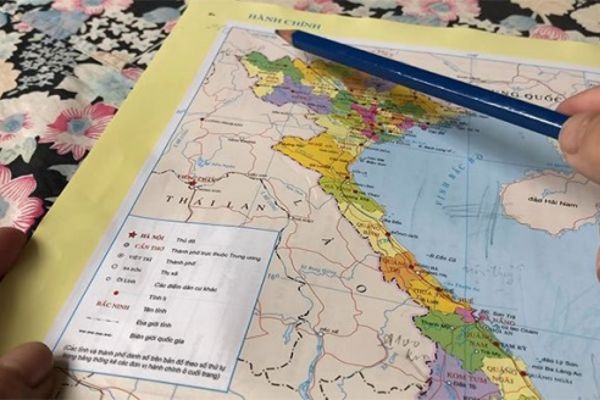Principles for the Arrangement of Administrative Units at District and Commune Levels in the Period 2023 - 2030: What are the Regulations?
Which District and Communal-Level Administrative Units are Subject to Arrangement During the Period 2023 - 2030?
On July 12, 2023, the Standing Committee of the National Assembly issued Resolution 35/2023/UBTVQH15 on the arrangement of district and communal-level administrative units for the period 2023-2030.
According to Resolution 35/2023/UBTVQH15, the district and communal-level administrative units subject to arrangement in the period 2023 - 2030 are divided into smaller phases, including the phase from 2023-2025 and the phase 2026-2030, specifically as follows:
- The district and communal-level administrative units subject to arrangement in the period 2023 - 2025 include:
+ District and communal-level administrative units simultaneously having a natural area and population size below 70% of the standards of the corresponding administrative unit as stipulated in Resolution 1211/2016/UBTVQH13 revised and supplemented by Resolution 27/2022/UBTVQH15 (hereinafter referred to as the Standing Committee of the National Assembly’s Resolution on criteria for administrative units and classification of administrative units);
+ District-level administrative units simultaneously having a natural area below 20% and a population size below 200% of the standards of the corresponding administrative unit stipulated in the Standing Committee of the National Assembly’s Resolution on criteria for administrative units and classification of administrative units;
+ Communal-level administrative units simultaneously having a natural area below 20% and a population size below 300% of the standards of the corresponding administrative unit stipulated in the Standing Committee of the National Assembly’s Resolution on criteria for administrative units and classification of administrative units.
- The district and communal-level administrative units subject to arrangement in the period 2026 - 2030 include:
+ District and communal-level administrative units simultaneously having a natural area and population size below 100% of the standards of the corresponding administrative unit stipulated in the Standing Committee of the National Assembly’s Resolution on criteria for administrative units and classification of administrative units;
+ District-level administrative units simultaneously having a natural area below 30% and a population size below 200% of the standards of the corresponding administrative unit stipulated in the Standing Committee of the National Assembly’s Resolution on criteria for administrative units and classification of administrative units;
+ Communal-level administrative units simultaneously having a natural area below 30% and a population size below 300% of the standards of the corresponding administrative unit stipulated in the Standing Committee of the National Assembly’s Resolution on criteria for administrative units and classification of administrative units.

Principles for Arrangement of District and Communal-Level Administrative Units in the Period 2023 - 2030 (Image from Internet)
What are the Principles for Arranging District and Communal-Level Administrative Units in the Period 2023 - 2030?
According to Article 2 of Resolution 35/2023/UBTVQH15, the principles for arranging district and communal-level administrative units are as follows:
- Ensure the leadership of the Communist Party and enhance the leadership and guidance role of the heads of agencies and organizations in the implementation of arranging district and communal-level administrative units.
- The arrangement of district and communal-level administrative units must comply with the Constitution, and must be conducted in accordance with the authority, order, and procedures stipulated by law.
- The arrangement of district and communal-level administrative units must ensure conformity with provincial planning, rural planning, urban planning, or other relevant plans.
- Carefully consider specific factors related to historical traditions, culture, ethnicity, religion, beliefs, customs, geographical location, natural conditions, community, and requirements to ensure national defense, security, social order, and safety, as well as economic and social development.
- Focus on and effectively conduct propaganda and mobilization of the People to create consensus, support, and high unanimity on the policy of arranging district and communal-level administrative units.
- Ensure public, transparent, and legally compliant organization of voter consultations in the area.
- Connect the arrangement of district and communal-level administrative units with the reorganization and streamlining of the political system, ensuring effective and efficient operation.
- Implement staffing reductions, restructure, and improve the quality of the team of officials and public employees, and workers.
- Reasonably resolve policies for officials and public employees, and workers.
- Implement special support policies for district and communal-level administrative units after arrangement.
What are the Regulations on Naming and Renaming Administrative Units Formed After Arrangement in the Period 2023 - 2030?
According to Article 6 of Resolution 35/2023/UBTVQH15, the regulations on naming and renaming administrative units formed after arrangement are as follows:
Naming and Renaming Administrative Units Formed After Arrangement
1. The naming and renaming of administrative units formed after arrangement are to be conducted in accordance with the Law on Organization of Local Government and the Standing Committee of the National Assembly’s Resolution on criteria for administrative units and classification of administrative units; ensuring ethnic unity, suitability with local historical, traditional, cultural factors, and respecting the opinions of the majority of voters.
2. In cases of merging administrative units at the same level, the use of one of the existing names of the pre-merger administrative units to name the newly formed administrative unit is encouraged.
The naming and renaming of administrative units formed after arrangement need to adhere to the provisions of the Law on Organization of Local Government and relevant laws.
However, the naming and renaming must ensure ethnic unity, be suitable with local historical, traditional, and cultural factors, and respect the opinions of the majority of voters.
At the same time, using one of the existing names of the administrative units before the arrangement is encouraged.
LawNet